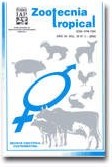
|
Zootecnia Tropical
Instituto Nacional de Investigaciones Agrícolas Venezuela
ISSN: 0798-7269
Vol. 27, No. 1, 2009, pp. 7-15
|
 Bioline Code: zt09002
Bioline Code: zt09002
Full paper language: Spanish
Document type: Research Article
Document available free of charge
|
|
|
Zootecnia Tropical, Vol. 27, No. 1, 2009, pp. 7-15
| es |
Evaluación de la fertilidad y eclosión en la codorniz japonesa
Galíndez, Rafael; De Basilio, Vasco; Martínez, Gonzalo; Vargas, Daniel; Uztariz, Edwin & Mejía, Patricia
Resumen
Con el objetivo de estudiar el efecto de algunos factores no genéticos sobre la fertilidad y eclosión de huevos de
codornices ( Coturnix Coturnix japonica

) sometidas a diferentes modalidades de apareamiento, se realizaron tres
análisis de varianza asumiendo una distribución binomial de los datos. Se utilizaron 2.613 registros para fertilidad
(FER), 2.178 para eclosión de huevos totales (EHT) y 1.403 para eclosión de huevos fértiles (EHF) provenientes
de codornices experimentales. Se incluyeron los efectos mes de postura, generación y tipo de apareamiento para
FER y para EHT y EHF se adicionaron el peso del huevo, color y brillo de la cáscara. Se ofreció agua y alimento
ad libitum. La relación macho: hembra fue 1:3. El sistema de reproducción comprendió dos modalidades: rotativo
y continuo. Se encontraron promedios de 78,7 25,8 y 42,3% para FER, EHT y EHF, respectivamente. El mes
de mayor (P<0,01) fertilidad fue marzo (91,1%), mientras que el menor mes fue noviembre (51,7%). La mayor
eclosión (P<0,01) ocurrió en agosto (42,6 y 65,7%) y la menor se observó en abril (12,5 y 17,9%) para EHT y EHF,
respectivamente. Hubo mayor fertilidad (P<0,01 86,2%) en los huevos provenientes de apareamientos continuos.
Los huevos que presentaron mayor porcentaje de eclosión (P<0,01) fueron aquellos de cáscara brillante (43,9%),
color oscuro (48,0%) y pesos intermedios (10,1 a 11,0 g; 44,0%). Se concluye que los huevos de color oscuro,
cáscara brillante y peso intermedio, puestos en meses lluviosos y almacenados por menos de 8 días presentan
ventajas en la incubación. Asimismo, en sistemas donde no es necesario el apareamiento rotativo se recomienda
usar el apareamiento continuo.
Palabras-clave
eclosión, incubación, Coturnix coturnix japonica, sistema de apareamiento, color de cáscara, brillo de cáscara.
|
| |
| en |
Evaluation of the fertility and hatchability in Japanese quails
Galíndez, Rafael; De Basilio, Vasco; Martínez, Gonzalo; Vargas, Daniel; Uztariz, Edwin & Mejía, Patricia
Abstract
With the aim to study the effect of some non genetic factors on fertility and hatchability of quails ( Coturnix Coturnix japonica

) under two different reproduction systems (modalities of matching), three analyses of variance
were realized assuming a binomial distribution of the data. There were used 2613 records for fertility (FE),
2178 for total hatchability (TH), and 1413 for fertile hatchability (FH) from a group of experimental quails. The
effects of month of lay, generation, and type of matching were included for FE and for TH and FH were added
egg weight, eggshell color and sheen. Water and food were offered ad libitum. The relation male: female was 1:3.
Two modalities of reproduction were studied: rotary (rotating the male) and continuous (permanent presence of
the male). Fertility, TH and FH averages were 78.7, 25.8, and 42.3%, respectively. The month of higher (P<0.01)
fertility was March (91.1%), whereas November had the lowest (51.7%). The higher TH and FH (P<0.01) was in
August (42.6 and 65.7%) and the lower TH and FH were observed in April (12.5 and 17.9%). There was higher
fertility (P<0.01, 86.2%) in the eggs from continuous reproduction system. Eggs with higher TH (P<0.01) were
those of brilliant eggshell (43.9%), dark color eggshell (48.0%) and intermediate weight (10.1 to 11.0 g; 44.0%).
It can be concluded that the eggs of dark color, brilliant eggshell, and intermediate weight laid in the rainy months had better properties for the process of incubation. Likewise, in farms where the rotary matching is not necessary,
it is advisable to use the continuous reproduction system.
Keywords
hatchability, incubation, Coturnix coturnix japonica, reproduction system, eggshell color, eggshell sheen.
|
| |
© Copyright 2009 - Zootecnia Tropical
Alternative site location: http://www.sian.inia.gob.ve/repositorio/revistas_ci/ZootecniaTropical/ztindice.htm
|
|
